Analysis of Vietnam's Aviation Sector: ECON6001 Report on Economics
VerifiedAdded on 2023/01/11
|8
|1641
|78
Report
AI Summary
This report examines the economics of Vietnam's aviation sector, focusing on supply and demand dynamics, the impact of price ceilings, and the price elasticity of demand. It analyzes the market forces at play, illustrating how increased supply from various airlines affects equilibrium prices. The report further explores the consequences of government-imposed price ceilings, detailing their effects on demand, supply, and the resulting market imbalances like shortages. It also evaluates the benefits of price controls to consumers and the losses incurred by producers, using diagrams to illustrate the shifts in consumer and producer surplus and the emergence of deadweight loss. Finally, the report investigates the determinants of price elasticity of demand within the aviation sector, considering factors like the availability of substitutes, income proportion, and the time frame involved, to provide a comprehensive economic analysis of the Vietnamese aviation market.
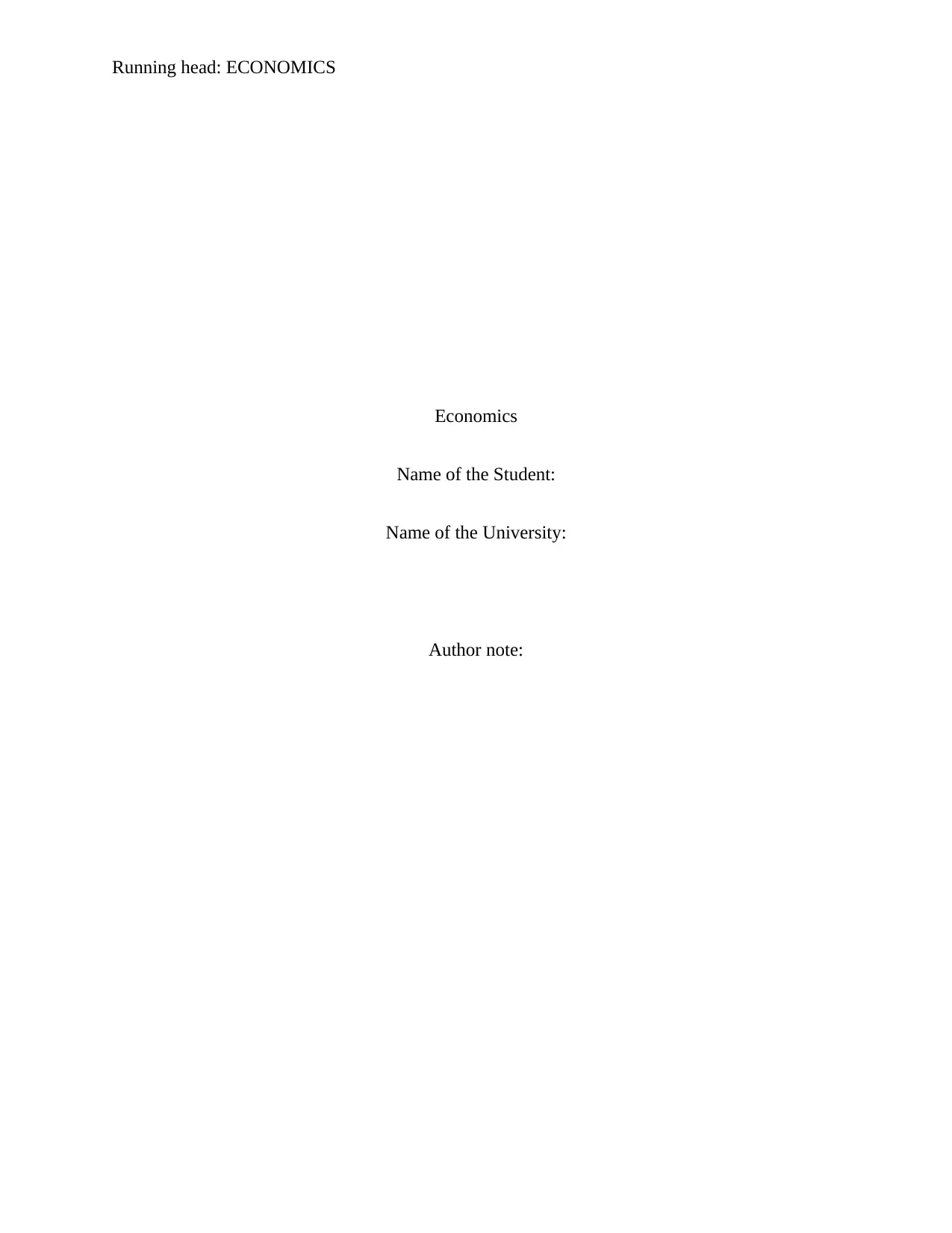
Running head: ECONOMICS
Economics
Name of the Student:
Name of the University:
Author note:
Economics
Name of the Student:
Name of the University:
Author note:
Paraphrase This Document
Need a fresh take? Get an instant paraphrase of this document with our AI Paraphraser
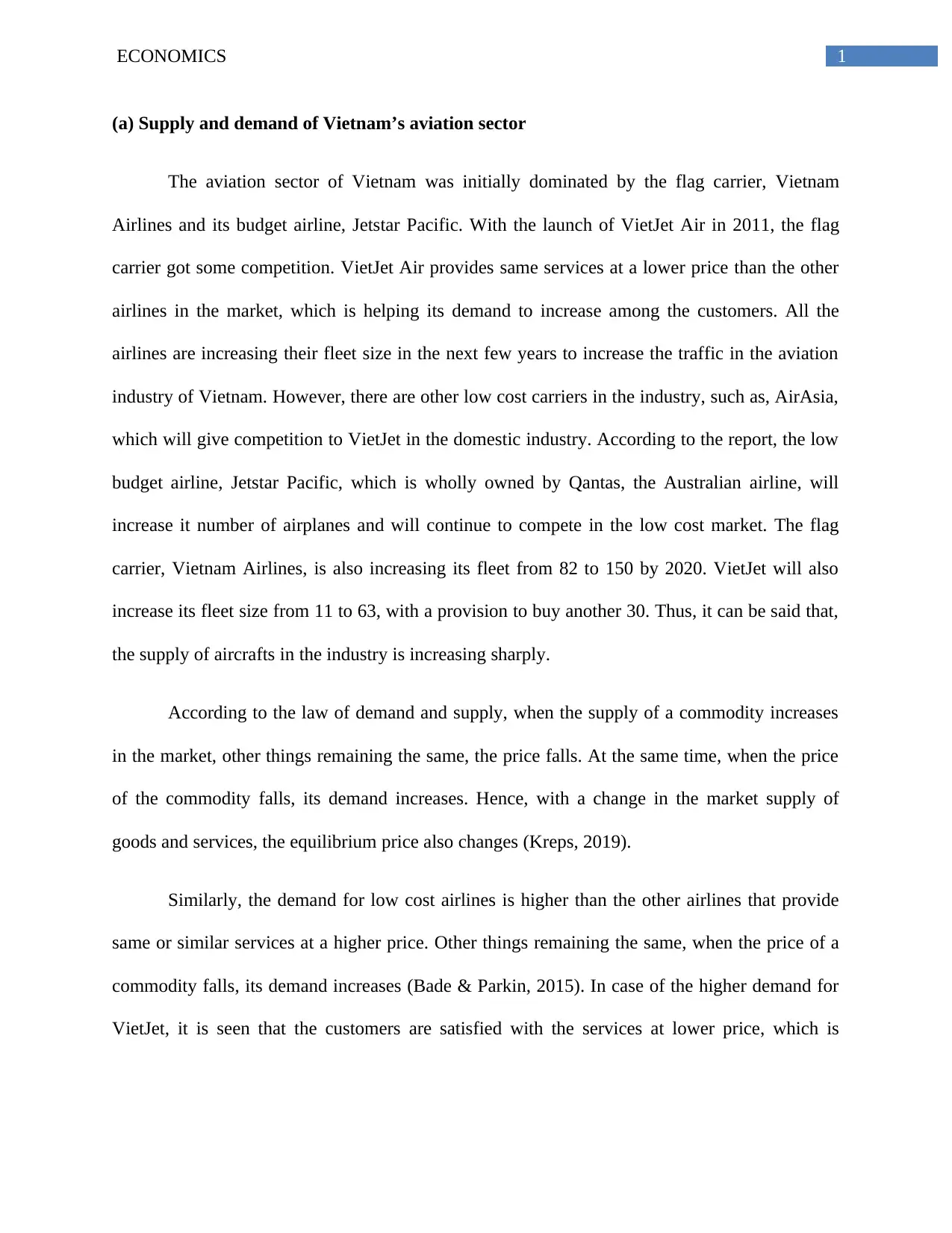
1ECONOMICS
(a) Supply and demand of Vietnam’s aviation sector
The aviation sector of Vietnam was initially dominated by the flag carrier, Vietnam
Airlines and its budget airline, Jetstar Pacific. With the launch of VietJet Air in 2011, the flag
carrier got some competition. VietJet Air provides same services at a lower price than the other
airlines in the market, which is helping its demand to increase among the customers. All the
airlines are increasing their fleet size in the next few years to increase the traffic in the aviation
industry of Vietnam. However, there are other low cost carriers in the industry, such as, AirAsia,
which will give competition to VietJet in the domestic industry. According to the report, the low
budget airline, Jetstar Pacific, which is wholly owned by Qantas, the Australian airline, will
increase it number of airplanes and will continue to compete in the low cost market. The flag
carrier, Vietnam Airlines, is also increasing its fleet from 82 to 150 by 2020. VietJet will also
increase its fleet size from 11 to 63, with a provision to buy another 30. Thus, it can be said that,
the supply of aircrafts in the industry is increasing sharply.
According to the law of demand and supply, when the supply of a commodity increases
in the market, other things remaining the same, the price falls. At the same time, when the price
of the commodity falls, its demand increases. Hence, with a change in the market supply of
goods and services, the equilibrium price also changes (Kreps, 2019).
Similarly, the demand for low cost airlines is higher than the other airlines that provide
same or similar services at a higher price. Other things remaining the same, when the price of a
commodity falls, its demand increases (Bade & Parkin, 2015). In case of the higher demand for
VietJet, it is seen that the customers are satisfied with the services at lower price, which is
(a) Supply and demand of Vietnam’s aviation sector
The aviation sector of Vietnam was initially dominated by the flag carrier, Vietnam
Airlines and its budget airline, Jetstar Pacific. With the launch of VietJet Air in 2011, the flag
carrier got some competition. VietJet Air provides same services at a lower price than the other
airlines in the market, which is helping its demand to increase among the customers. All the
airlines are increasing their fleet size in the next few years to increase the traffic in the aviation
industry of Vietnam. However, there are other low cost carriers in the industry, such as, AirAsia,
which will give competition to VietJet in the domestic industry. According to the report, the low
budget airline, Jetstar Pacific, which is wholly owned by Qantas, the Australian airline, will
increase it number of airplanes and will continue to compete in the low cost market. The flag
carrier, Vietnam Airlines, is also increasing its fleet from 82 to 150 by 2020. VietJet will also
increase its fleet size from 11 to 63, with a provision to buy another 30. Thus, it can be said that,
the supply of aircrafts in the industry is increasing sharply.
According to the law of demand and supply, when the supply of a commodity increases
in the market, other things remaining the same, the price falls. At the same time, when the price
of the commodity falls, its demand increases. Hence, with a change in the market supply of
goods and services, the equilibrium price also changes (Kreps, 2019).
Similarly, the demand for low cost airlines is higher than the other airlines that provide
same or similar services at a higher price. Other things remaining the same, when the price of a
commodity falls, its demand increases (Bade & Parkin, 2015). In case of the higher demand for
VietJet, it is seen that the customers are satisfied with the services at lower price, which is
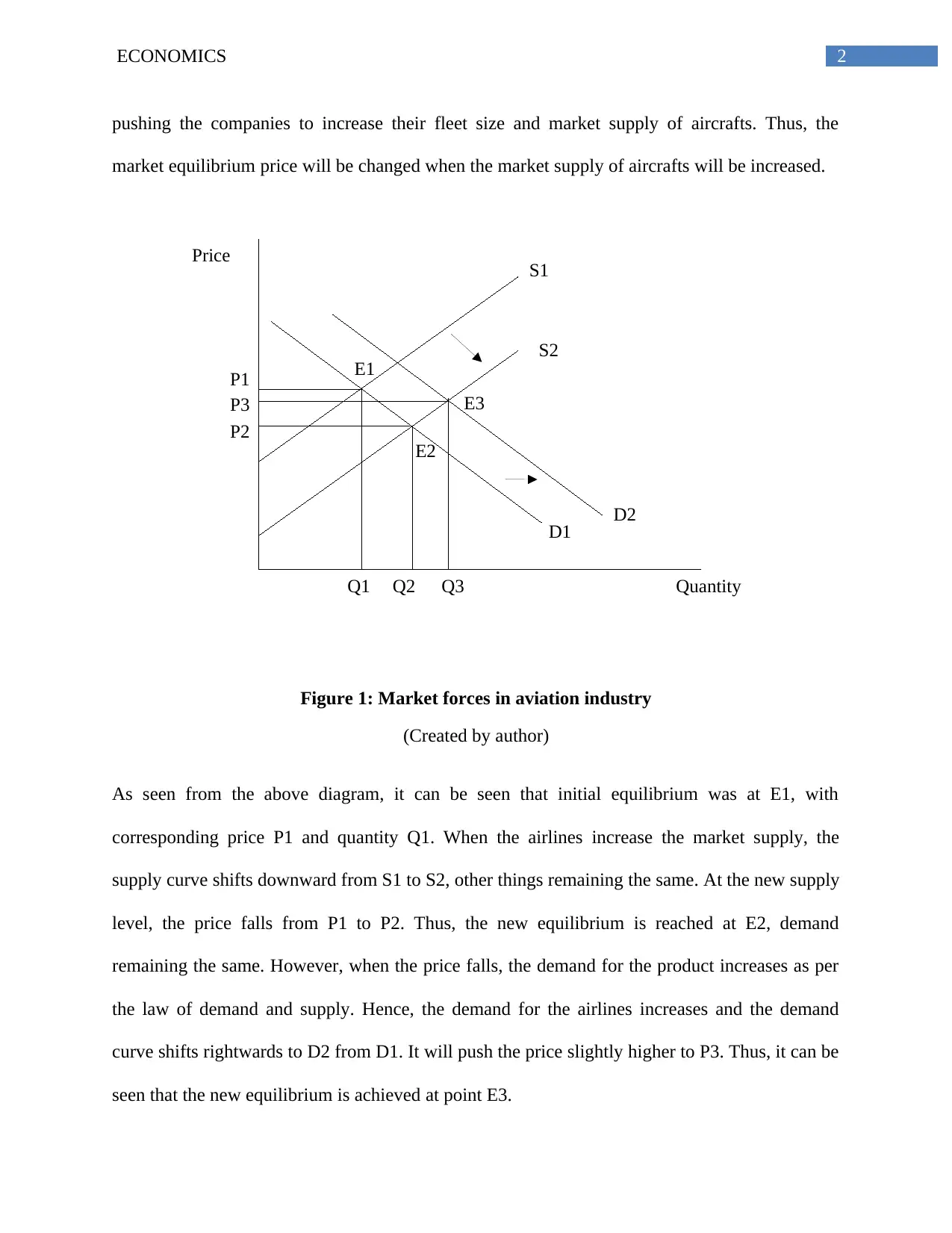
2ECONOMICS
S1
S2
D1
Price
Quantity
P1
P2
E1
E2
Q1 Q2
D2
Q3
P3 E3
pushing the companies to increase their fleet size and market supply of aircrafts. Thus, the
market equilibrium price will be changed when the market supply of aircrafts will be increased.
Figure 1: Market forces in aviation industry
(Created by author)
As seen from the above diagram, it can be seen that initial equilibrium was at E1, with
corresponding price P1 and quantity Q1. When the airlines increase the market supply, the
supply curve shifts downward from S1 to S2, other things remaining the same. At the new supply
level, the price falls from P1 to P2. Thus, the new equilibrium is reached at E2, demand
remaining the same. However, when the price falls, the demand for the product increases as per
the law of demand and supply. Hence, the demand for the airlines increases and the demand
curve shifts rightwards to D2 from D1. It will push the price slightly higher to P3. Thus, it can be
seen that the new equilibrium is achieved at point E3.
S1
S2
D1
Price
Quantity
P1
P2
E1
E2
Q1 Q2
D2
Q3
P3 E3
pushing the companies to increase their fleet size and market supply of aircrafts. Thus, the
market equilibrium price will be changed when the market supply of aircrafts will be increased.
Figure 1: Market forces in aviation industry
(Created by author)
As seen from the above diagram, it can be seen that initial equilibrium was at E1, with
corresponding price P1 and quantity Q1. When the airlines increase the market supply, the
supply curve shifts downward from S1 to S2, other things remaining the same. At the new supply
level, the price falls from P1 to P2. Thus, the new equilibrium is reached at E2, demand
remaining the same. However, when the price falls, the demand for the product increases as per
the law of demand and supply. Hence, the demand for the airlines increases and the demand
curve shifts rightwards to D2 from D1. It will push the price slightly higher to P3. Thus, it can be
seen that the new equilibrium is achieved at point E3.
⊘ This is a preview!⊘
Do you want full access?
Subscribe today to unlock all pages.

Trusted by 1+ million students worldwide
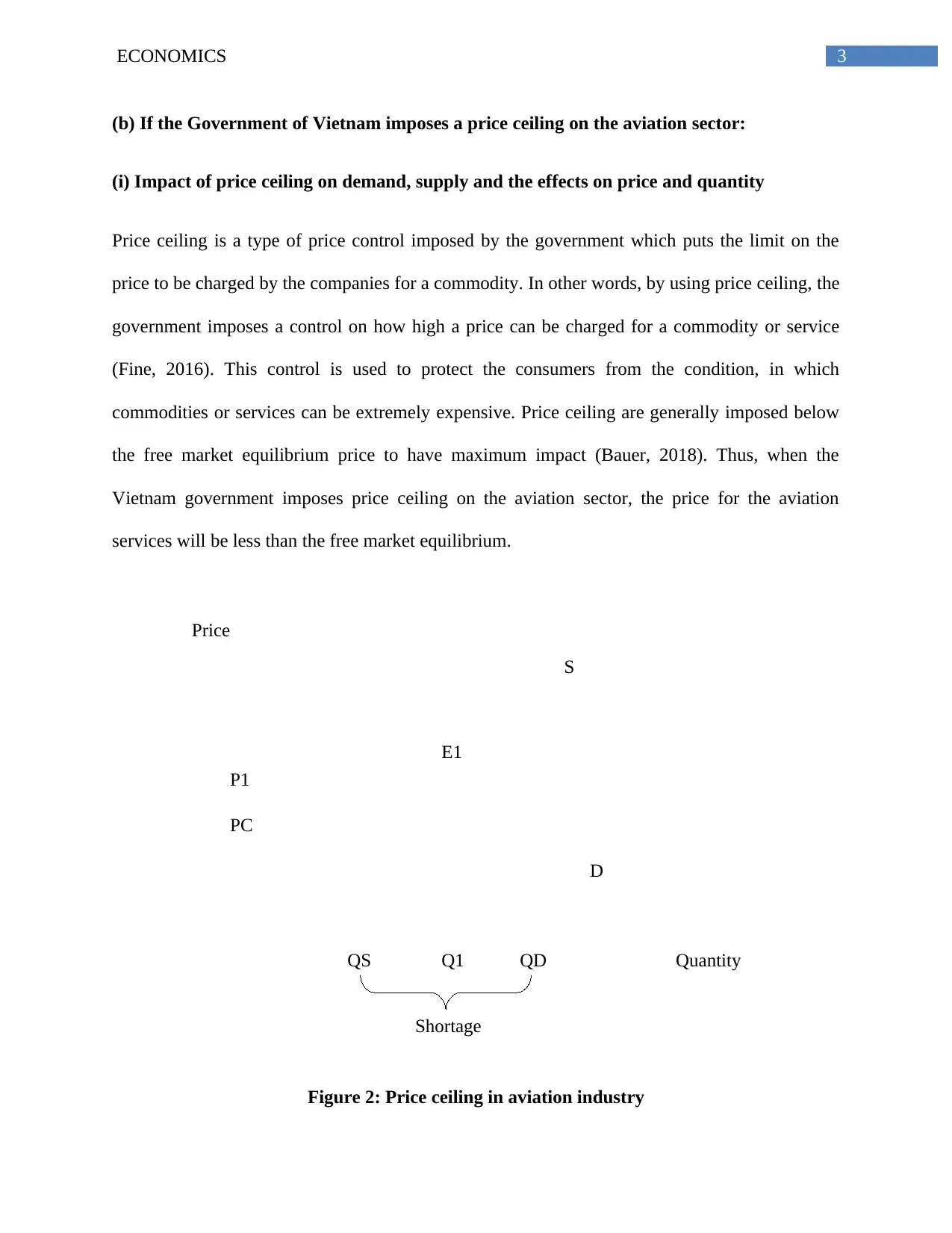
3ECONOMICS
S
D
Price
Quantity
PC
QS QDQ1
P1
E1
Shortage
(b) If the Government of Vietnam imposes a price ceiling on the aviation sector:
(i) Impact of price ceiling on demand, supply and the effects on price and quantity
Price ceiling is a type of price control imposed by the government which puts the limit on the
price to be charged by the companies for a commodity. In other words, by using price ceiling, the
government imposes a control on how high a price can be charged for a commodity or service
(Fine, 2016). This control is used to protect the consumers from the condition, in which
commodities or services can be extremely expensive. Price ceiling are generally imposed below
the free market equilibrium price to have maximum impact (Bauer, 2018). Thus, when the
Vietnam government imposes price ceiling on the aviation sector, the price for the aviation
services will be less than the free market equilibrium.
Figure 2: Price ceiling in aviation industry
S
D
Price
Quantity
PC
QS QDQ1
P1
E1
Shortage
(b) If the Government of Vietnam imposes a price ceiling on the aviation sector:
(i) Impact of price ceiling on demand, supply and the effects on price and quantity
Price ceiling is a type of price control imposed by the government which puts the limit on the
price to be charged by the companies for a commodity. In other words, by using price ceiling, the
government imposes a control on how high a price can be charged for a commodity or service
(Fine, 2016). This control is used to protect the consumers from the condition, in which
commodities or services can be extremely expensive. Price ceiling are generally imposed below
the free market equilibrium price to have maximum impact (Bauer, 2018). Thus, when the
Vietnam government imposes price ceiling on the aviation sector, the price for the aviation
services will be less than the free market equilibrium.
Figure 2: Price ceiling in aviation industry
Paraphrase This Document
Need a fresh take? Get an instant paraphrase of this document with our AI Paraphraser
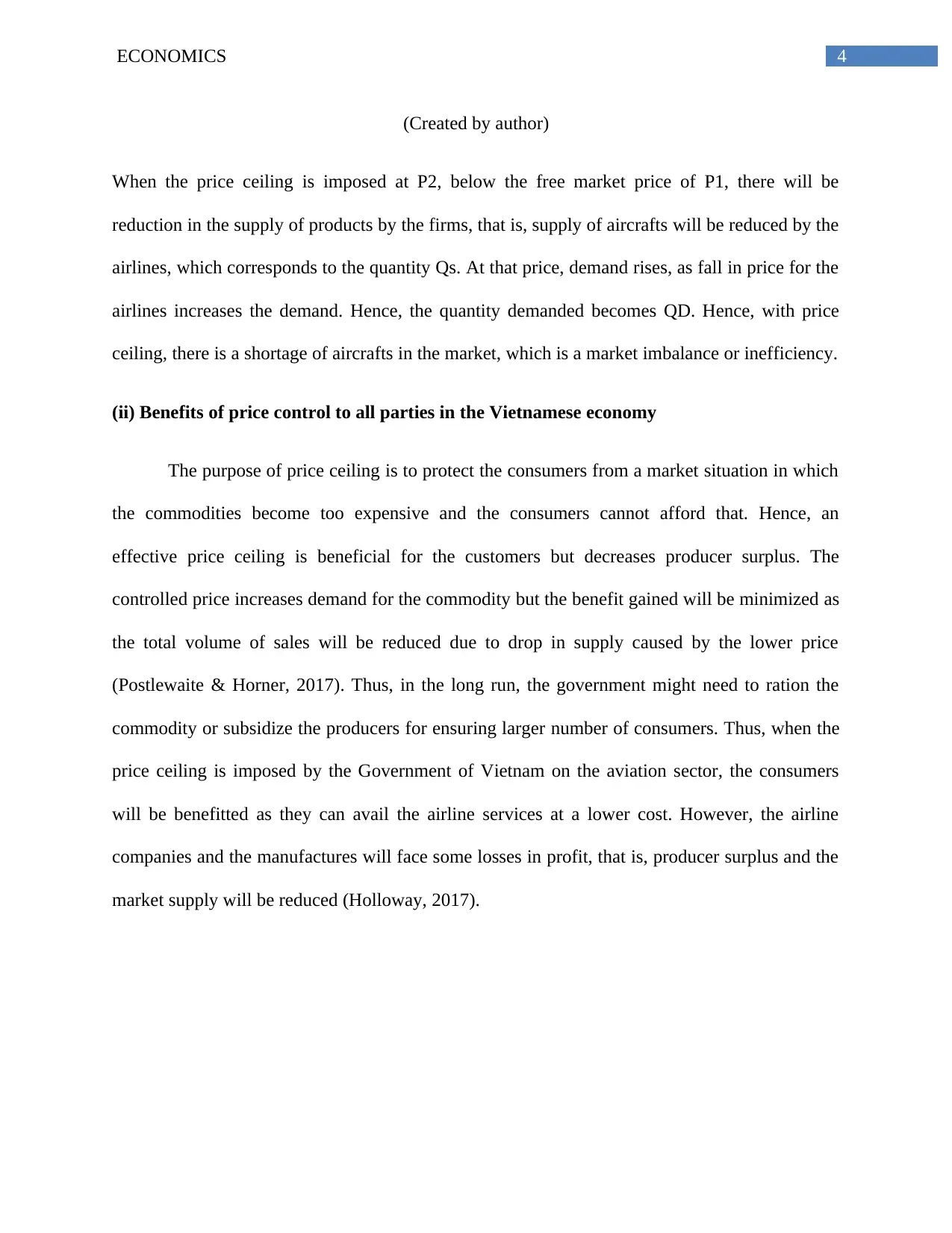
4ECONOMICS
(Created by author)
When the price ceiling is imposed at P2, below the free market price of P1, there will be
reduction in the supply of products by the firms, that is, supply of aircrafts will be reduced by the
airlines, which corresponds to the quantity Qs. At that price, demand rises, as fall in price for the
airlines increases the demand. Hence, the quantity demanded becomes QD. Hence, with price
ceiling, there is a shortage of aircrafts in the market, which is a market imbalance or inefficiency.
(ii) Benefits of price control to all parties in the Vietnamese economy
The purpose of price ceiling is to protect the consumers from a market situation in which
the commodities become too expensive and the consumers cannot afford that. Hence, an
effective price ceiling is beneficial for the customers but decreases producer surplus. The
controlled price increases demand for the commodity but the benefit gained will be minimized as
the total volume of sales will be reduced due to drop in supply caused by the lower price
(Postlewaite & Horner, 2017). Thus, in the long run, the government might need to ration the
commodity or subsidize the producers for ensuring larger number of consumers. Thus, when the
price ceiling is imposed by the Government of Vietnam on the aviation sector, the consumers
will be benefitted as they can avail the airline services at a lower cost. However, the airline
companies and the manufactures will face some losses in profit, that is, producer surplus and the
market supply will be reduced (Holloway, 2017).
(Created by author)
When the price ceiling is imposed at P2, below the free market price of P1, there will be
reduction in the supply of products by the firms, that is, supply of aircrafts will be reduced by the
airlines, which corresponds to the quantity Qs. At that price, demand rises, as fall in price for the
airlines increases the demand. Hence, the quantity demanded becomes QD. Hence, with price
ceiling, there is a shortage of aircrafts in the market, which is a market imbalance or inefficiency.
(ii) Benefits of price control to all parties in the Vietnamese economy
The purpose of price ceiling is to protect the consumers from a market situation in which
the commodities become too expensive and the consumers cannot afford that. Hence, an
effective price ceiling is beneficial for the customers but decreases producer surplus. The
controlled price increases demand for the commodity but the benefit gained will be minimized as
the total volume of sales will be reduced due to drop in supply caused by the lower price
(Postlewaite & Horner, 2017). Thus, in the long run, the government might need to ration the
commodity or subsidize the producers for ensuring larger number of consumers. Thus, when the
price ceiling is imposed by the Government of Vietnam on the aviation sector, the consumers
will be benefitted as they can avail the airline services at a lower cost. However, the airline
companies and the manufactures will face some losses in profit, that is, producer surplus and the
market supply will be reduced (Holloway, 2017).
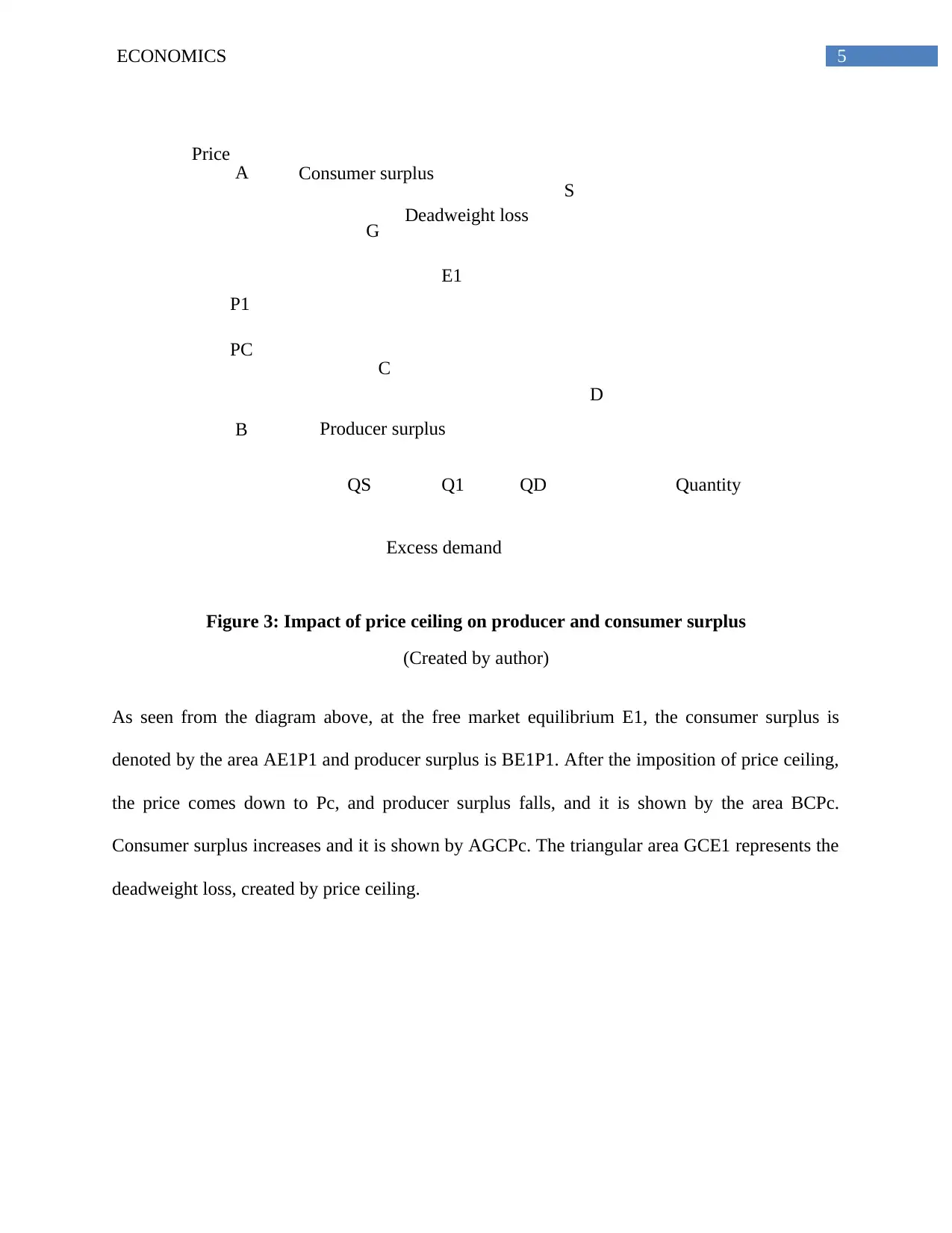
5ECONOMICS
S
D
Price
Quantity
PC
A
QS QDQ1
P1
E1
Excess demand
B
C
G Deadweight loss
Consumer surplus
Producer surplus
Figure 3: Impact of price ceiling on producer and consumer surplus
(Created by author)
As seen from the diagram above, at the free market equilibrium E1, the consumer surplus is
denoted by the area AE1P1 and producer surplus is BE1P1. After the imposition of price ceiling,
the price comes down to Pc, and producer surplus falls, and it is shown by the area BCPc.
Consumer surplus increases and it is shown by AGCPc. The triangular area GCE1 represents the
deadweight loss, created by price ceiling.
S
D
Price
Quantity
PC
A
QS QDQ1
P1
E1
Excess demand
B
C
G Deadweight loss
Consumer surplus
Producer surplus
Figure 3: Impact of price ceiling on producer and consumer surplus
(Created by author)
As seen from the diagram above, at the free market equilibrium E1, the consumer surplus is
denoted by the area AE1P1 and producer surplus is BE1P1. After the imposition of price ceiling,
the price comes down to Pc, and producer surplus falls, and it is shown by the area BCPc.
Consumer surplus increases and it is shown by AGCPc. The triangular area GCE1 represents the
deadweight loss, created by price ceiling.
⊘ This is a preview!⊘
Do you want full access?
Subscribe today to unlock all pages.

Trusted by 1+ million students worldwide
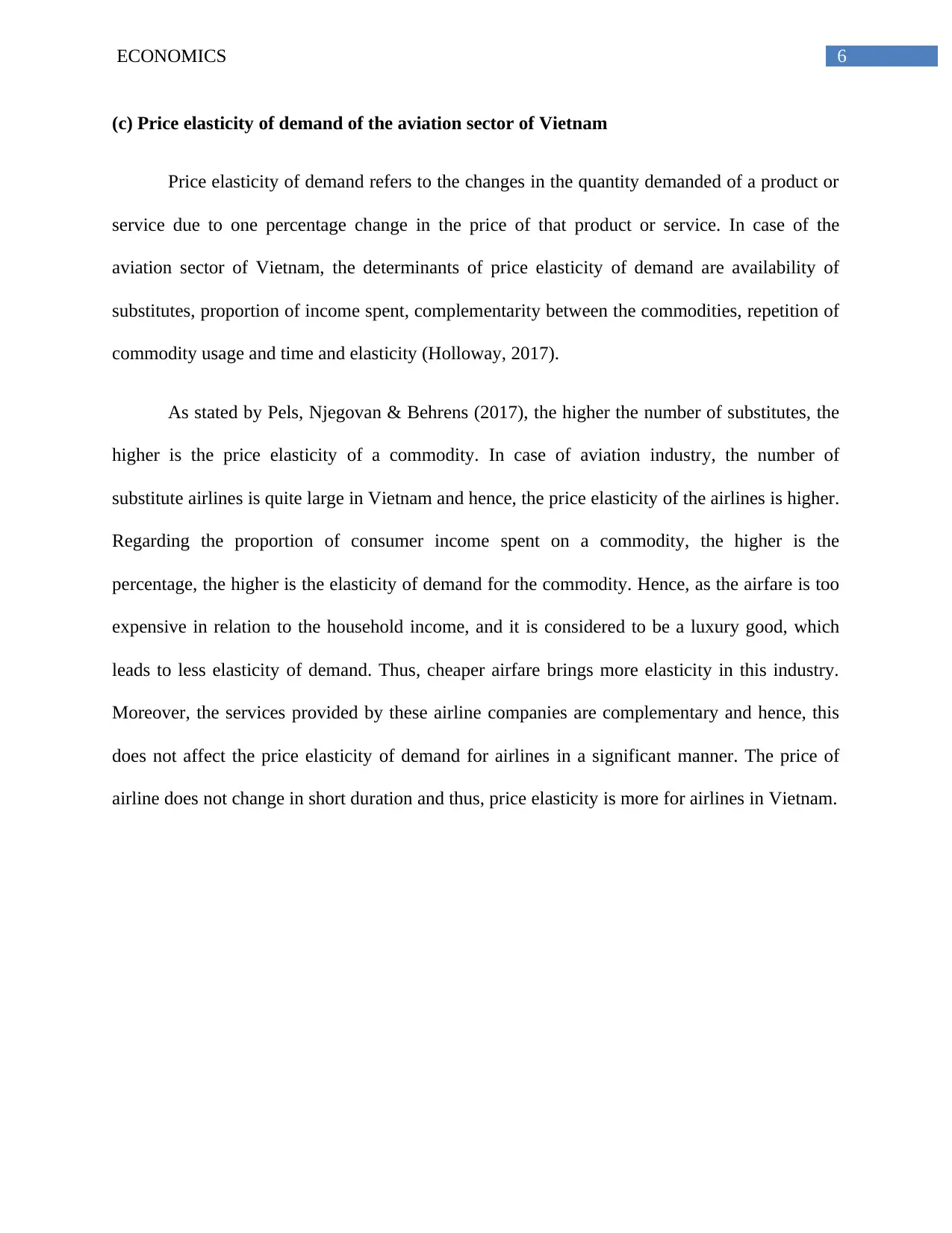
6ECONOMICS
(c) Price elasticity of demand of the aviation sector of Vietnam
Price elasticity of demand refers to the changes in the quantity demanded of a product or
service due to one percentage change in the price of that product or service. In case of the
aviation sector of Vietnam, the determinants of price elasticity of demand are availability of
substitutes, proportion of income spent, complementarity between the commodities, repetition of
commodity usage and time and elasticity (Holloway, 2017).
As stated by Pels, Njegovan & Behrens (2017), the higher the number of substitutes, the
higher is the price elasticity of a commodity. In case of aviation industry, the number of
substitute airlines is quite large in Vietnam and hence, the price elasticity of the airlines is higher.
Regarding the proportion of consumer income spent on a commodity, the higher is the
percentage, the higher is the elasticity of demand for the commodity. Hence, as the airfare is too
expensive in relation to the household income, and it is considered to be a luxury good, which
leads to less elasticity of demand. Thus, cheaper airfare brings more elasticity in this industry.
Moreover, the services provided by these airline companies are complementary and hence, this
does not affect the price elasticity of demand for airlines in a significant manner. The price of
airline does not change in short duration and thus, price elasticity is more for airlines in Vietnam.
(c) Price elasticity of demand of the aviation sector of Vietnam
Price elasticity of demand refers to the changes in the quantity demanded of a product or
service due to one percentage change in the price of that product or service. In case of the
aviation sector of Vietnam, the determinants of price elasticity of demand are availability of
substitutes, proportion of income spent, complementarity between the commodities, repetition of
commodity usage and time and elasticity (Holloway, 2017).
As stated by Pels, Njegovan & Behrens (2017), the higher the number of substitutes, the
higher is the price elasticity of a commodity. In case of aviation industry, the number of
substitute airlines is quite large in Vietnam and hence, the price elasticity of the airlines is higher.
Regarding the proportion of consumer income spent on a commodity, the higher is the
percentage, the higher is the elasticity of demand for the commodity. Hence, as the airfare is too
expensive in relation to the household income, and it is considered to be a luxury good, which
leads to less elasticity of demand. Thus, cheaper airfare brings more elasticity in this industry.
Moreover, the services provided by these airline companies are complementary and hence, this
does not affect the price elasticity of demand for airlines in a significant manner. The price of
airline does not change in short duration and thus, price elasticity is more for airlines in Vietnam.
Paraphrase This Document
Need a fresh take? Get an instant paraphrase of this document with our AI Paraphraser
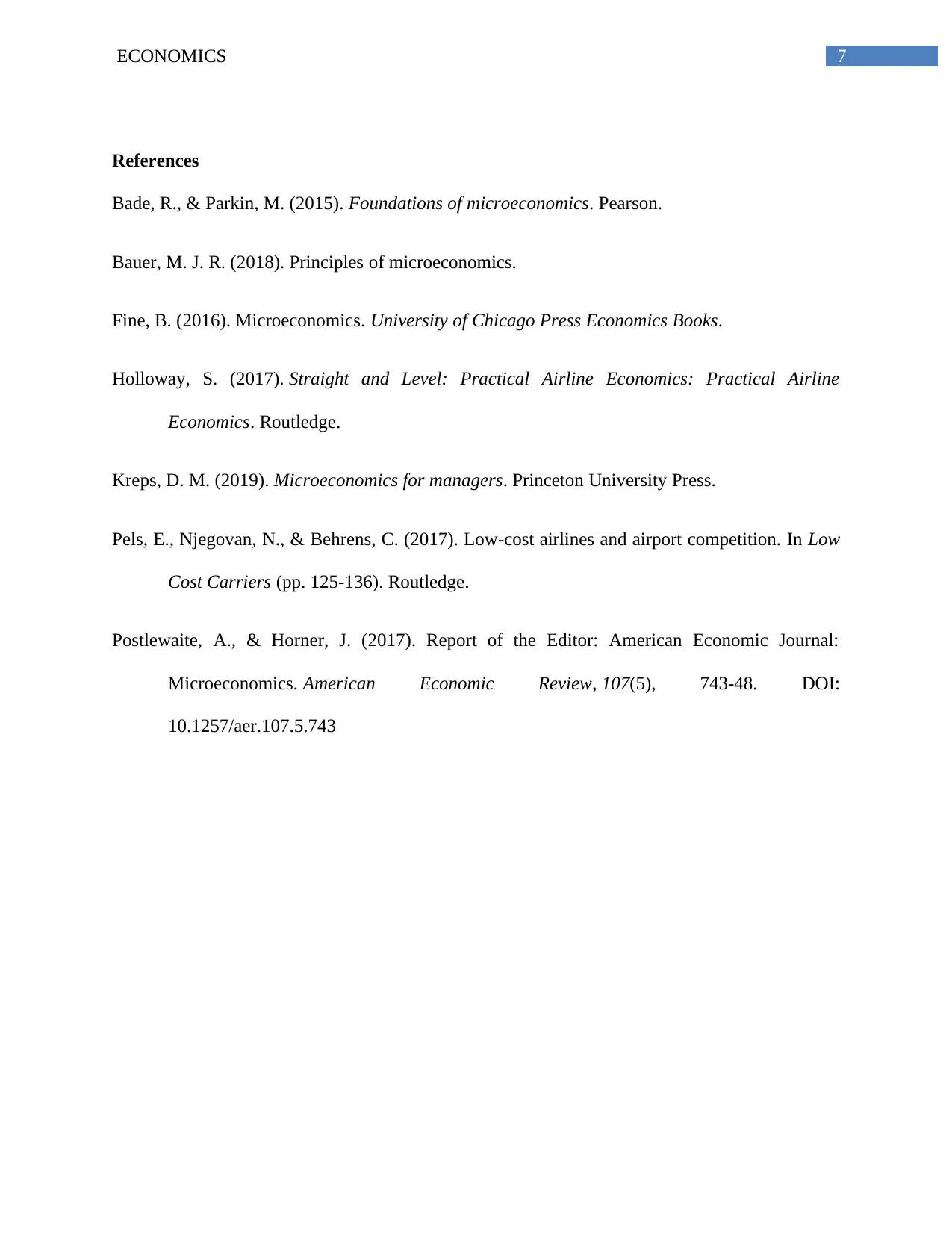
7ECONOMICS
References
Bade, R., & Parkin, M. (2015). Foundations of microeconomics. Pearson.
Bauer, M. J. R. (2018). Principles of microeconomics.
Fine, B. (2016). Microeconomics. University of Chicago Press Economics Books.
Holloway, S. (2017). Straight and Level: Practical Airline Economics: Practical Airline
Economics. Routledge.
Kreps, D. M. (2019). Microeconomics for managers. Princeton University Press.
Pels, E., Njegovan, N., & Behrens, C. (2017). Low-cost airlines and airport competition. In Low
Cost Carriers (pp. 125-136). Routledge.
Postlewaite, A., & Horner, J. (2017). Report of the Editor: American Economic Journal:
Microeconomics. American Economic Review, 107(5), 743-48. DOI:
10.1257/aer.107.5.743
References
Bade, R., & Parkin, M. (2015). Foundations of microeconomics. Pearson.
Bauer, M. J. R. (2018). Principles of microeconomics.
Fine, B. (2016). Microeconomics. University of Chicago Press Economics Books.
Holloway, S. (2017). Straight and Level: Practical Airline Economics: Practical Airline
Economics. Routledge.
Kreps, D. M. (2019). Microeconomics for managers. Princeton University Press.
Pels, E., Njegovan, N., & Behrens, C. (2017). Low-cost airlines and airport competition. In Low
Cost Carriers (pp. 125-136). Routledge.
Postlewaite, A., & Horner, J. (2017). Report of the Editor: American Economic Journal:
Microeconomics. American Economic Review, 107(5), 743-48. DOI:
10.1257/aer.107.5.743
1 out of 8
Related Documents
Your All-in-One AI-Powered Toolkit for Academic Success.
+13062052269
info@desklib.com
Available 24*7 on WhatsApp / Email
![[object Object]](/_next/static/media/star-bottom.7253800d.svg)
Unlock your academic potential
Copyright © 2020–2025 A2Z Services. All Rights Reserved. Developed and managed by ZUCOL.




